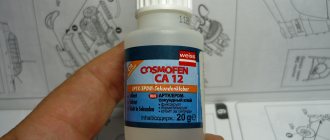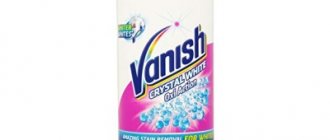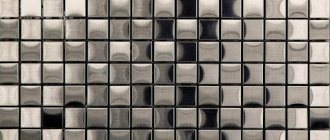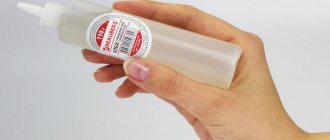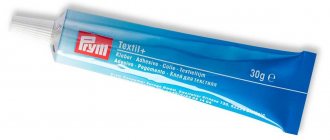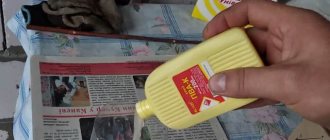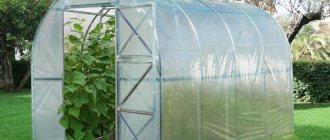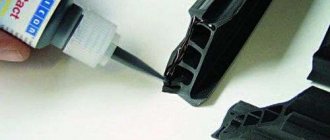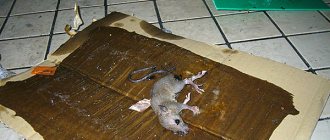When constructing structures made of foam concrete, specialists use special glue. It is a special dry mixture consisting of Portland cement, fractionated sand and technical additives.
Below we will look at how to use such compositions, and also find out how much glue for foam blocks costs.
Bag of dry adhesive mixture
Mixture composition
Naturally, glue for laying cellular blocks comes in the form of a dry mixture from which it is subsequently made. The basis of such a mixture is always Portland cement, which is essentially very fine quartz sand, thanks to which the strength of the already hardened composition is achieved.
In addition to it, there are also various modifiers that retain moisture, allowing the glue to harden correctly, and also prevent the appearance of cracks, which is also completely undesirable. The plasticity of the mass, which allows the composition to fill all cavities, is increased by various polymer additives, which in turn increases the adhesion between the block and the solution, ensuring the strength of the structure.
Types and composition
When choosing an adhesive mixture, it is necessary to take into account the operating conditions. In accordance with this, materials are divided into 2 groups:
- winter;
- summer
In the first case, assembly adhesive for foam concrete can be used at temperatures within +5...+30°C.
At the same time, the mixture retains its properties and will serve for a long period without loss of quality. It is not recommended to prepare this type of glue in large volumes.
A high drying rate is noted - after 1-2 hours the composition begins to harden. When the consistency of the mixture changes, it cannot be used, because this will not ensure a sufficiently high-quality adhesion. When mixing summer glue, it is recommended to use white cement.
Winter mixtures are intended for use in more severe conditions: the temperature at which the substance can be applied varies between +5...-10°C. This allows you to lay foam blocks in winter without fear of reducing the quality of adhesion of materials.
The disadvantage of such adhesives is the need for their rapid consumption after mixing.
So, after half an hour the mixture will begin to harden, which will make it impossible to further use it for laying blocks. Hot water is used to prepare the glue. It also contains antifreeze components.
When using summer or winter glue, the ratio of components must be observed. Changing the amount of materials may cause deterioration in the properties of the finished mixture.
The glue contains the following components:
Fine quartz sand creates thin seams.
- fine-grained quartz sand allows you to create thin joints - up to 3 mm thick;
- Portland cement makes it possible to obtain a strong connection, and the composition hardens quickly;
- plasticizers or polymer additives are used to increase the plasticity of the finished mass, as a result it better fills leaks, which helps to increase the quality of the masonry, since the mixture covers the entire surface of the block, including small irregularities;
- special components that help retain moisture, thereby increasing the service life of the finished structure, as the risk of cracks is reduced.
Types of glue
The construction process is an almost year-round affair and you never know in what weather it will be carried out, be it a hot summer or a snowy winter. Of course, in most cases, many builders and construction companies try to plan their work, but if you do not want it to stand still during a certain season, then manufacturers of building materials and in particular adhesive compositions have provided the market with two types: summer and winter.
Summer line-up:
The peculiarity of this mixture is white cement, and it sets within two hours after adding water, so you need to carefully monitor this. Naturally, this glue is used during construction in the warm season, and the operating temperature is considered to be from 5 to 30 degrees Celsius.
Winter composition:
Here we can judge from the name that this mixture is used to work in colder weather, with temperatures ranging from +5 to -10 degrees Celsius on average. Essentially, this mixture has the same composition, but in addition to the main components, it also contains anti-frost agents. You need to dilute the mixture with water, which according to the instructions should be heated to 60 degrees, and this mixture hardens in just 30-40 minutes, so it is best to mix the glue in small portions and work quickly.
Adhesive consumption for foam blocks
The consumption of glue for foam blocks per m3 may vary depending on the specific type of composition and the skill of the masons.
Advice! Before you begin, carefully read the instructions included with the adhesive. After all, only its exact observance will allow you to obtain a high-quality mixture.
Please note that only professionals will be able to carry out the laying properly, while sparingly using the adhesive mass. By creating seams about three millimeters thick, they will have a glue consumption for foam blocks per m2 of approximately 6 kilograms.
Only professionals can carry out quality masonry work
The mixture used, in addition to connecting blocks, can also be used to level various surfaces. The setting time will be 3-4 hours. As for the required strength, the composition will gain no earlier than in a day.
- Adhesive for foam blocks
Proportions for preparing the solution
Basically, professional builders always know what proportions of the components are needed for a certain amount of mixture, but if suddenly you are just starting to be interested in this topic, you can always find a “recipe” for preparing a solution using a bag with the composition.
The rules for preparing the mixture will also be located there. But if for some reason they were not there, then it is worth noting that they are quite simple and will be accessible to absolutely everyone:
- pour the contents of the bag (approximately 25 kg) into a clean container;
- pour in about seven to eight liters of water;
- using a drill mixer, mix the mixture at low rotation speed, bringing the solution to a homogeneous state;
- After five minutes of “ripening” the solution, it can be used.
This is what the standard preparation instructions look like, and checking the plasticity of the mixture will be quite simple; you just need to apply it with a spatula to the surface of the block and see if it spreads. When the glue thickens, you can always stir it with a mixer, but you still shouldn’t leave the mixture unused for more than 2 hours.
It will also be important to note, as already written above, that the technology for preparing glue from the winter composition differs quite a bit from the main one as follows:
- the water must be hot (at least 60 degrees Celsius);
- the temperature of the finished working mixture should not fall below +10 degrees;
- the “life” of such a solution at sub-zero temperatures is no more than half an hour;
- Never apply glue to blocks covered with frost, hoarfrost or snow.
Preparation of glue
The amount of water to prepare the glue is added as written on the package. It is better to stir with a mixer, or you can use a drill with an attachment; the speed should be set to low. After obtaining a homogeneous mass, the solution should stand for about five minutes.
The consistency should not be too liquid; the glue should stick to the trowel. The prepared solution must be used within the time specified in the instructions; styling correction can be carried out within fifteen minutes. The glue will harden for another 4 hours, complete hardening occurs after 24 hours.
It is better to stir with a mixer, or you can use a drill with an attachment; the speed should be set to low.
Masonry process
First of all, it is worth noting that when working with foam blocks, the first row is always placed on cement mortar, in order to avoid various (certainly possible) unevenness of the foundation, and glue is used from the second row.
During the laying process, if you are working with ordinary, standard blocks, then glue must be applied not only to the horizontal edges, but also to the vertical ones. In the case of using blocks with a tongue-and-groove connection, applying an adhesive solution to the vertical ends is optional, if not necessary.
Naturally, it is also best to prepare the blocks themselves immediately before laying, cleaning them from dust and possible fine dirt so that the glue is applied to an absolutely clean surface.
Why glue?
Disadvantages of cement mortar
As you know, foam concrete is actively used in construction due to its high thermal insulation properties. But the use of cement mortar to create masonry from foam blocks inevitably leads to a deterioration in the heat and sound insulating properties of the constructed wall.
Laying foam blocks on cement mortar
The thing is that the cement layer between the foam blocks has high thermal conductivity. During operation, this inevitably leads to the hardened solution forming “cold bridges”. This is the name given to the sections of the wall through which heat escapes from the house. .
Reducing the cement layer to a thickness of several millimeters will reduce heat loss, but will lead to another problem. A thin layer of mortar will not be strong enough. Glue for foam blocks will help solve the above problems.
Advantages of special glue
The advantages of the adhesive composition are that it:
- quickly gains the required strength - this is achieved due to the use in its composition without additional Portland cement;
- it can be applied in a thin layer, 2-3 mm thick - this possibility occurs due to the presence of fractional sand in the mixture;
The adhesive seams are quite thin
- has increased moisture-holding capacity - it is provided by special additives;
- improves the thermal insulation of walls;
- has high adhesion - peel strength.
Glue selection
Before starting work, the question will inevitably arise about what adhesive composition is worth purchasing.
We advise you to heed the following recommendations:
- You should not choose a mixture from the lowest price category - cheap compounds, as a rule, are of low quality. Medium-priced goods with a price tag of around 200 rubles are usually quite suitable;
- If possible, it is worth purchasing glue from a well-known and well-established brand - for example, it could be Knauf, Osnovit or Bergauf. The cost of such products can reach up to 300 rubles or more;
The photo shows an adhesive mixture from a well-known manufacturer
- For construction in the cold season, you need to use winter glue - it contains special frost-resistant additives. But even it should not be used at air temperatures below -10ºС.
Benefits of using glue
The use of adhesive for laying cellular concrete blocks has a number of positive features, which in turn affect many more or less important indicators, both at the construction stage and ultimately.
Among the main advantages are the following:
- the ability to achieve a minimum thickness of seams, which in turn virtually eliminates the formation of “cold bridges”, which prevents frost from entering the house;
- taking into account the same small thickness of the seams, the consumption of the adhesive mixture is much less than that of cement-sand;
- time savings achieved by reduced labor intensity in the production and preparation of the solution, which is required in small quantities;
- there is no need for any bulky mixer, everything is done with your own hands using a construction mixer or a drill with a special attachment;
- The heat and sound insulation properties of foam block walls also increase;
- excellent moisture-resistant qualities of the mixture exclude the absorption of moisture, and, consequently, the formation of fungus, mold, etc.;
- production becomes much easier, and thanks to smooth walls, the cost of finishing work is also reduced;
- and, of course, all the components included in the mixture cause absolutely no harm to the human body;
A brief overview of the main properties and qualities of adhesive for foam blocks
Before starting masonry work, many probably wondered: what is better to choose, specialized glue or ordinary cement mortar? To answer this question, you need, first of all, to understand the properties of each, to understand what function the material should perform, and what negative consequences can result from a wrong choice.
Advantages of specialized adhesives compared to alternative solutions
Some builders and developers are considering using cement mortar instead of expensive glue when constructing walls as an alternative. Is it correct? The answer lies in understanding the properties and purpose of both materials and foam concrete blocks.
Since foam concrete blocks will be used when laying walls, it is worth taking into account their main features, the main one of which is their low thermal conductivity. Cement, in turn, is almost the exact opposite of products made from cellular concrete. Thus, when using this material, the joints will become the main source of cold, since the capacity of cold and heat in cement is extremely high.
To avoid such consequences, you should follow the recommendations of the manufacturer of foam concrete blocks, which indicate the need to use an adhesive composition when constructing walls.
Block adhesive has many benefits. It will not only speed up the work process, but also emphasize the advantages of the foam block.
The main ones are:
- Easy to handle the adhesive mixture and, most importantly, the speed of laying the blocks. Some manufacturers claim that 1 m3 of masonry blocks, with a professional approach, can take only 30 minutes of time.
- High peel strength.
- Reducing costs for masonry work. Despite the fact that a bag of specialized mixture is more expensive than regular cement mortar, the price of installation using these materials differs significantly. The cost increases taking into account manual kneading and time spent. As a result, using an adhesive composition will cost about 1.5 times less.
- No mold in seams or cracks caused by temperature changes.
- The range of adhesive mixtures includes a winter composition, which allows work to be done at sub-zero temperatures.
- High plasticity of the finished material, allowing the masonry to be adjusted over a certain period of time (until it hardens completely).
It is also worth noting that the thickness of the seams when using glue is much less. This involves increasing the level of heat retention and, as a result, reducing the cost of insulating and heating the building.
Glue consumption and factors influencing it
The adhesive consumption for foam concrete blocks is quite low, but this largely depends on the quality of the purchased products. If the foam block has ideal geometry, there are no chips or other errors on it, the glue consumption will be minimal and equal to approximately 1 bag per 1 m3 of masonry.
There are other factors that directly affect the consumption of the adhesive composition.
This:
- Mason skill level
- Levelness of the foundation
- Weather
Experts still recommend purchasing the mixture with a small supply of several bags, especially if you plan to do the masonry work yourself and for the first time. Much depends on which manufacturer owns the adhesive for foam concrete; the consumption of the finished mixture in this case is individual.
Flaws
As for the disadvantages, there are none in terms of direct use of the adhesive mixture.
But the cost of these compositions is still relatively high, so at this stage they are mainly used for small buildings. However, despite the fact that cement mortar can be much cheaper, with the correct geometry and accurate calculations you will most likely be able to save a lot of money, since with the above advantages and the high plasticity of the mixture, glue for masonry can use up to six times less than cement mortar . And here you don’t need to be a mathematician to calculate the difference in costs, so this disadvantage is also very ambiguous.
Main stages of work
After choosing and purchasing glue, you can get to work. Let's consider the main stages, as well as the technological features of laying foam block walls using an adhesive composition.
Work should begin with surface preparation. It must be free of dust and dirt, which may adversely affect adhesion.
Required set of tools
Preparing the mixture
The second stage in the work is preparing the adhesive mixture. You should first carefully read the instructions and follow all the manufacturer’s instructions, since if the proportions of the dry composition and the added liquid are incorrect, the properties of the material can significantly deteriorate.
To mix, you will need a bucket (or other suitable container) and a drill with a special attachment. The dry mixture and water are mixed, forming a thick, viscous mass. After preparation, you must begin work immediately to avoid setting the solution.
Advice! If it happens that you did not have time to develop the mixture and it thickened significantly or completely hardened, you should not dilute it with water. Many manufacturers warn consumers against such actions, citing the loss of properties and qualities of the material. It is better to mix the glue in small portions to avoid such troubles.
Masonry technology
The next step will be the process of applying glue and laying the block on it. To improve adhesion, you can first use a deep penetration primer.
The first block is laid from the corner. With a perfectly level foundation, you can choose any angle; in other cases, the highest point is determined. This is where we should start.
The layer of glue, of course, in this place will be the thinnest. Foam concrete blocks located in the corners will serve as a guide for further work.
Installing the first reference block
A cord is pulled between these blocks. If the distance is too large (more than five meters, for example), it is recommended to install additional beacons at the joints of load-bearing walls.
The first row of the block is laid exclusively on cement mortar. This will improve the strength of the structure and adhesion to the foundation, and will also help the developer save money, since the use of glue when laying the first row is quite impractical due to its higher cost compared to cement mortar. It can also be used to correct imperfections in the foundation of the house, such as unevenness.
The solution is applied, and then the adhesive mixture using a notched trowel directly in a row or on the top and side surfaces of the foam block. You can and should control the process using a level and a rubber hammer.
The first layer of the block should have a layer thickness of about 1-1.5 centimeters horizontally and a little less vertically, but this largely depends on the geometry of the blocks themselves. The seams must be completely filled with mortar to avoid the appearance of cracks.
During operation, the block can be cut to the desired size and given a certain shape.
Cutting foam block during laying
After laying the first row, it is subjected to reinforcement. The second and subsequent rows are laid according to the same principle, only using an adhesive composition.
Laying foam blocks: second row from the corner
Excess glue is removed and returned to the container with the main adhesive mixture, and used again for greater savings.
How to lay foam concrete on glue
Advice! During laying, try to stir the solution occasionally, as it tends to separate.
After applying the glue, the blocks are pressed tightly against each other to avoid gaps. The glue begins to set in about 10-15 minutes. During this period of time it is possible to correct the evenness of the foam blocks. It should be checked after laying every third or fourth product.
The masonry usually hardens completely within 24 hours, but this indicator can vary significantly depending on weather conditions. If the walls are erected not in one, but in two layers, then bandaging is required between them.
The best manufacturers of adhesives
So, you have decided to use adhesive for the masonry of your future home or other building and it is time to choose a composition on which you will entrust one of the most important missions, namely the strength and integrity of the structure.
Today, the building materials market is filled with various companies and brands, and the category of mixtures is no exception, providing quite a wide choice. So for a more optimal solution, it’s worth considering the three best and most popular options, from world leaders and simply proven brands.
Ceresit
One of the most popular brands of building materials, mixtures and other things is the Ceresit and it deservedly occupies a high position, thanks to numerous recommendations and its exceptional quality.
Made on the basis of cement with mineral fillers and an organic modifier, the Ceresit adhesive mixture is perfect for thin-layer masonry of external and internal walls made of gas or foam blocks.
This adhesive composition is produced in bags weighing 25 kg.
Knauf
Also quite a popular solution among many construction companies and professional builders themselves are compounds from Knauf , which, thanks to their gypsum base, provide high and durable adhesion quality.
The environmentally friendly composition of Knauf Perlfix does not have any adverse effects on humans, and its plasticity allows you to quickly level the blocks.
This adhesive composition is produced in bags weighing 30 kg.
Adhesive solutions for laying foam blocks
Adhesive for laying foam blocks is often used to replace mortars. They have a high level of adhesion. which has a positive effect on the performance properties of the material. When working, it is necessary to apply the composition in a thin layer. Solutions reduce heat loss. Drying of the mixtures takes less time than required by cement compositions.
Cement mortars draw moisture from foam blocks, which leads to their cracking and destruction.
When working, it is necessary to apply the composition in a thin layer.
Differences between glue and cement mortar, why it is better
The construction scheme for structures made of foam blocks has its own characteristics that differ from the laying of the same gas blocks, and cement mortars are not very suitable for this purpose. Foam concrete has good heat-insulating properties, and cement mortar does not reach this level. In this regard, layers of cement composition promote ventilation of the room. To reduce the process, it will be necessary to additionally insulate the walls.
Or you can replace the cement mortar with special glue. The layer will be thin, providing good sealing, thereby retaining heat inside the building. At the same time, laying with glue is easier, the composition sets faster. Cement mortar uses water, it is saturated into the porous structure of the material; to avoid this, a moisture-repellent primer should also be applied.
True, the use of cement-based mortar is sometimes allowed:
- The size of the blocks is approximately thirty centimeters;
- Uneven shape of products;
- The height deviation reaches more than one and a half centimeters;
- Presence of chips.
In other cases, it is preferable to choose glue for foam blocks.
Laying with glue is easier, the composition sets faster.
Advantages and disadvantages
Special adhesive solutions for foam blocks were created for a reason; their use has a number of advantages compared to other installation options. They are:
- The composition includes fine-grained Portland cement, this allows you to obtain a thin coating, reducing product consumption;
- The distribution occurs evenly, thus achieving better fixation of the blocks;
- The optimal ratio of water for preparing glue, allowing you to obtain good humidity levels in the room, improving microclimatic conditions;
- The solution helps retain heat;
- Features a high degree of adhesion to the material;
- Resistance to natural factors;
- Setting occurs without shrinkage;
- Can be used as a putty solution;
- Ease of working with the product.
The negative side is the high cost of production.
But, if we take into account the low consumption, the cost will not be so different from the alternative option - cement mortar.
The distribution occurs evenly, thus achieving better fixation of the blocks.
Average price for adhesive compositions in the Russian Federation
To correctly calculate the cost of construction work, you need to know the average price for the material in Russia:
- Ceresit – from 300 to 350 rubles;
- Volma - from 193 to 230 rubles;
- Founder - from 200 to 250 rubles;
- Ytong – from 275 to 350 rubles;
- KREISEL - from 200 to 275 rubles.
Most formulations are sold in powder form in 20 or 25 kg paper bags. This packaging is optimal for masonry work.
Tips for choosing
The composition of the mixture for laying foam concrete is approximately similar. The difference is in the percentage of fillers and polymer additives. Therefore, when choosing, you need to familiarize yourself with the composition and manufacturer. If you carry out work in the winter season, it is better to give preference to frost-resistant glue. In the case of construction in the warm season, there is no point in overpaying. If you want to purchase an imported composition, then read the application and preparation features to make sure whether it is suitable for our conditions.
If you are unsure of your choice, it is better to turn to professionals who understand adhesives for foam concrete. You need to follow several rules:
- do not take the cheapest product;
- give preference to adhesives from trusted manufacturers;
- take into account construction time;
- After all the calculations, take one bag in reserve.
Return to contents
Consumption
Construction adhesive for foam concrete is a mixture in a dry consistency, which is diluted with water right before installing the foam blocks. Using a drill or construction mixer, the solution is stirred to a homogeneous consistency, after which the glue should be allowed to sit for 15-20 minutes so that all components are completely dissolved. Then the solution is mixed again and you can start working.
When planning construction work, it is necessary to calculate the required amount of glue; for this, we proceed from its standard consumption per cubic meter of surface.
For calculations, builders recommend starting with a seam thickness of 3 mm. In this case, the glue consumption per cubic meter for foam concrete masonry will approximately be about 20 kg. In practice, most inexperienced finishers cannot evenly spread the solution in a thin layer, and the coating thickness is approximately 5 mm. The same is observed in the case when the foam blocks are not of high quality and have a few defects and irregularities. As a result, glue consumption will be higher and amount to 30-35 kg/m3. If you need to convert this indicator to m2, then you need to divide the resulting value by the wall thickness parameter.
Is it possible to save money? It is possible if you purchase gas foam blocks with profiled edges. Such blocks are joined in grooves, and only horizontal edges need to be coated with glue; vertical seams are not coated.
It is possible to reduce the consumption of the adhesive mixture by 25-30% if you use a notched trowel to apply it.
How to choose the best adhesive mixture
Despite the fact that all adhesive compositions consist of almost the same components, their characteristics are often different. Therefore, when choosing, pay attention to the following parameters:
- Strength . The compressive strength of high-quality glue after 28 days is 6-7 MPa. For external load-bearing walls, it is advisable not to use compounds with a strength of less than 5 MPa;
- Adhesion . Must be at least 0.2 MPa. It is advisable to use compounds with adhesion of 0.5-0.6 MPa;
An important parameter is the time during which masonry adhesive can be used
- Time to use the solution . As a rule, the solution can be used within 120 minutes after preparation;
- Frost resistance . The optimal value is 40-50 cycles.
It must be said that some manufacturers add perlite to the composition, which increases the thermal insulation properties of the glue. True, if you insulate the walls, for example, with mineral wool, the presence of perlite in the glue will not affect the thermal insulation properties of the walls.
It is better not to insulate walls made of cellular concrete with materials that do not allow moisture to pass through. These include polystyrene foam, penoplex, polyurethane foam, etc.
